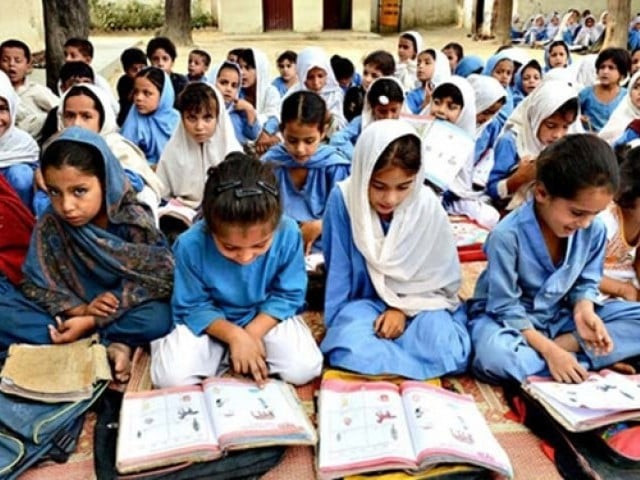
Last month, the Academy of Educational Planning and Management launched the ‘Pakistan Education Statistics (PES) 2014-15’ report. This piece denotes how such reports add value in informing where a province or region is and what type of course corrections can be envisaged to better the faltering results.
Five years after the 18th Constitutional Amendment (April, 2010), the provincial and regional governments exercise greater autonomy in education, along with the other devolved subjects relating to the social and economic sectors. Since taking charge of the province, some three years back, the current Khyber-Pakhtunkhwa (K-P) government made education a priority, and within that, elementary and secondary education in particular, has remained a top priority.
The key challenges to education in K-P, like in the other provinces and regions of the country, are access, quality, equity and governance. To improve these areas of the education sector, the government of K-P took substantive measures through policy and sector reforms.
The Pakistan Education Statistics (PES) 2014-15, launched by the Academy of Educational Planning and Management, provides an overview of the state of education across all provinces and regions. The key indicators reflected in the report, precisely focus on the outcome of government steps towards better quality education. The Elementary and Secondary Education Department of the K-P government, focused on improving the enrolment and retention of the students in government schools by improving quality of teaching and creating a better environment for learning.
The PES 2014-15 highlights the percentage of Out Of School Children (OOSC) falling under the age bracket of five to sixteen years. The analysis shows that K-P is the best performing province/region after Islamabad Capital Territory (ICT), with only 35.9 per cent of children of this age bracket being out of school.
K-P is well ahead of all four provinces, ICT and other regions, showing high improvement in Gross Intake Rate (GIR). This indicator relates to a number of new entrants in the first grade of primary education, regardless of age, expressed as a percentage of the population at the official primary school entrance age. The GIR of K-P in 2014-15 is 135 per cent compared to the 128 per cent of ICT and the 116 per cent and 111 percent of Punjab and Pakistan, respectively. The rest of the provinces and regions have recorded a lower GIR.
It is pertinent to note that after ICT, K-P’s girls’ GIR (120 per cent) remained well above others, such as Punjab’s 113 per cent, Gilgit Baltistan’s 108 per cent, the national average of Pakistan (104 per cent) and the rest of the provinces/regions. The GIR has improved over the last two years. Relative to the current year GIR of 135 per cent, it was 119.3 per cent in the year 2013-14 and 119.55 per cent in the year 2012-13.
Another important indicator is Gross Enrolment Rate (GER), which is the total enrolment for a particular education level (primary or secondary), regardless of age, expressed as a percentage of the eligible official school-age population of that particular education level, in a given school-year.
Followed by ICT (123 per cent), K-P is, again, higher on this indicator (110 per cent) than Punjab (95 per cent) and the national average of Pakistan (91 per cent). While other regions and provinces have an even lower GER. It is encouraging to note that following the ICT, the highest girls’ GER (93 per cent) is in K-P as compared with 92 per cent in Punjab and 83 per cent as the national average of Pakistan. The GER trend in K-P has improved over time as well. In relation to the 2014-15 GER of 110 per cent, it was 104 per cent in the year 2013-14 and 83 per cent in the year-2012-13.
Another positive outcome of K-P’s focus on elementary and secondary education, relates to the improved Adjusted Net Enrolment Rate (ANER), which shows the number of children at a given level of education who are of the officially stated age for that level. After the ICT (96 per cent), with an ANER of 86 per cent, the K-P, again, remained ahead of Punjab (76 per cent) and the national average of Pakistan (72 per cent) and the rest of the provinces/regions. The time series analysis also shows an increasing ANER trend, from 83.26 per cent (in 2012-13) and 85.1 per cent (in 2013-14) to 86 per cent (2014-15) in K-P.
The Elementary and Secondary Education Department of K-P, is evidently determined to increase access to quality education. The rolling out of enrolment campaigns, assessment of teachers’ capacities, rationalisation of the teaching staff, provision of the missing facilities in government schools and initiation of students’ assessment mechanisms, are a few of the critical steps taken to provide a better education environment for the community at large.
It is important to note that K-P has fared well on these indicators, despite the volatile security situation, which is not as challenging in other provinces and once that is also improved, K-P will shine further in its educational achievements.
Published in The Express Tribune, April 12th, 2016.
Like Opinion & Editorial on Facebook, follow @ETOpEd on Twitter to receive all updates on all our daily pieces.













COMMENTS
Comments are moderated and generally will be posted if they are on-topic and not abusive.
For more information, please see our Comments FAQ